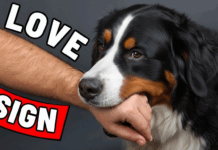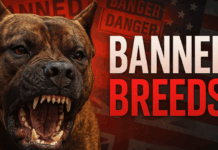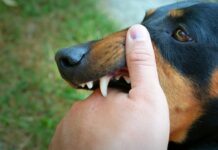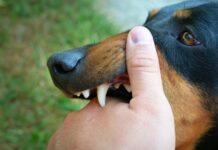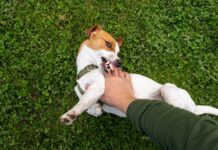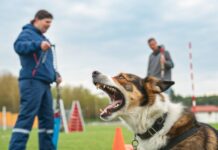Last Updated on September 25, 2022 by Dogs Vets
Can a pitbull live with another dog? Everything you need to know
Some people hear a pit bull and think it’s a “wicked dog”. But when the American Temperament Testing Society assessed the true credibility of this misunderstood breed and many others, they came to what some might consider a shocking conclusion.
Can Pitbulls live happily with another dog?
If the Pit Bull was never trained to fight, it is safe with other dogs. Pit Bulls are able to live peacefully with other dogs and animals. Historically, however, Pit Bulls have been bred to take down large animals. Early and ongoing socialization will help the pit bull to be more animal friendly.
Physical characteristics of the Pit Bull
The standard size of the American pit bull terrier varies from medium to large, ranging in weight from 30 to 90 pounds. The Pit Bull has a stocky, muscular build and a short, smooth coat of varying colors.
The Pit Bull’s variation in size and color is due to the breed being a mix of different types of Bulldogs and Terriers.
The body of the Pit Bull is long, with a short whip-like tail ending in a point. The small to medium-sized ears are set high on its broad, flat head. The Pit Bull’s most defining facial feature is its wide and powerful jaw.
Personality and temperament of the Pit Bull
Protective and fearless, the Pit Bull is known for its playful temperament and friendly nature. The Pit Bull is also athletic and has a strong desire to please.

The Pit Bull breed has a large prey drive as it is bred to chase and subdue livestock.
However, the Pit Bull is not naturally aggressive towards people and is affectionate towards children. Depending on early socialization and handling, the Pit Bull can learn to prevent itself from unwarranted aggression towards other dogs.
History and background of Pit Bulls
The origins of the Pit Bull can be traced back to early 19th century England, Ireland, and Scotland. The dogs’ ancestry was the result of experimental crossbreeding of various bulldog and terrier breeds for the purpose of baiting bears and bulls – a blood sport in which the dog was trained to attack until defeated by a larger animal.
When baiting was banned in the 1800s, dogs were bred for the sports of baiting and dogfighting. It was European immigrants who introduced the Pit Bull breed to North America.
The American Kennel Club does not recognize the Pit Bull because of its controversial origins. As a result, the Pit Bulls were specifically registered after forming two separate clubs.
The first was the United Kennel Club (UKC), founded in 1898 by founder C. Z. Bennett.
The founder’s dog Bennett’s Ring was assigned a UKC registration number, making it the first registered Pit Bull in recorded history.
The second club, the American Dog Breeders Association (ADBA), began in 1909 as a multi-breed club, but it is dedicated primarily to Pit Bulls.
Contrary to the dubious reputation of an aggressive breed, the Pit Bull is considered by many to be a friendly dog with a way out. With those loyal to the breed becoming increasingly active in educating and training the breed, the Pit Bull is once again a popular companion.
ATTS temperament test
The ATTS temperament test focuses on different aspects of temperament, such as stability, shyness, aggression, and friendliness, as well as the dog’s instinct to protect itself from its handler and/or to self-preserve in the face of danger.
The test simulates a random walk through a park or a neighborhood, where everyday situations are encountered. During this walk, the dog experiences visual, auditory, and tactile stimuli.
Neutral, friendly, and threatening situations are encountered, which play on the dog’s ability to distinguish between non-threatening situations and those that require a vigilant and protective response.
Let’s take a moment to watch a video that shows exactly what testing looks like.
American Staffordshire Terrier
American Staffordshire Terriers are stout, muscular, pull-type terriers that stand 17-19 inches at the shoulder. The head is broad, the jaws are well defined, the cheekbones are well defined and the dark round eyes are set well apart.
The American Staffordshire Terrier movement is brisk and graceful, with a graceful gait that advertises the breed’s natural confidence. The stiff, glossy coat comes in multiple colors and patterns.
American Staffordshire Terrier owners describe their dogs as being aware of their surroundings, playing with everything, and loving the “personality dogs” around the house. AmStaffers enjoy mental and physical challenges.
They are very trainable, as their many showbiz events suggest. There is only one way to go when owning an American Staffordshire Terrier: do your homework and find a responsible and registered reputable breeder.
National breed clubs and rescue workers
Want to socialize with others who love the same breed as much as you do? Thanks to AKC breed clubs located in every state and more than 450 AKC rescue groups across the country, there are plenty of opportunities to get involved in your local community.
Inquiries about adopting AmStaff can be directed to Joyce Martin at the American Staffordshire Terrier Club.
Food and nutrition for American Staffordshire Terrier
AmStaff should be able to handle quality dog food, whether commercially prepared or home-prepared, under the supervision and approval of your veterinarian.
Any diet should be appropriate to the age of the dog (puppy, adult, or senior). Certain tests should be carried out to ensure that the diet is suitable for the dog.
Treats can be an important help in training, but giving too many Treats can lead to obesity for your dog. Find out which human foods are safe for puppies and which are not. Ask your vet if at any point you have any concerns about your dog’s weight or diet. Moreover, make sure clean, freshwater should be available at all times.
Trimming and Grooming
Grooming the American Staffordshire Terrier short, stiff coat is remarkably easy. A quick once-weekly brushing with a soft-bristled brush is usually all that is needed to remove dirt or other foreign matter. What’s more, a good brushing will distribute the oils throughout the coat to keep it healthy.
If Am Staff gets into anything particularly messy, a bath will probably be called for. Otherwise, bathing can wait to see when and if he develops a “dog poop” smell.
As with all breeds, the American Staffordshire Terrier’s nails should be trimmed regularly, as excessively long nails can be painful and cause the dog problems when walking and running.
Exercise
This dog is considered an athletic and energetic dog. The American Staffordshire Terrier requires a lot of exercises. Leaving your dog outside all day is not the right approach, however: yes, he can run around, but AmStaff is a people-oriented dog who thrives on being part of the family.
Long playtimes with his owner will develop his physical and psychological health. In addition, many AmStaff enjoy participating in dog sports such as obedience, agility, and dock diving. AmStaffs are even trained in search and rescue and excel at it.
Training American Staffordshire Terrier
Early communication and puppy training classes are recommended for all breeds, but given the AmStaff’s strong will, physical strength, and exuberance, they are essential.
The intelligence of the breed and the desire to please make training a fun and easy process. Even so, certain behaviors, such as chewing and digging, can be difficult to manage.
It should be noted that canine aggression can develop even in a well-socialized AmStaff; the AmStaff should never be left alone with other dogs.
General health
The Am Staff is a vigorous and healthy breed, and a responsible breeder will monitor the breed for these health conditions, such as canine hip dysplasia, heart disease, and skin and coat allergies.
A genetic test for cerebellar ataxia, which causes a gradual loss of muscle coordination, has recently been developed, first appearing between the ages of 3 and 5 years; now, by identifying dogs with the mutation, breeders can prevent its development in their bloodlines.
As with all breeds, ears should be checked regularly and the dog’s teeth brushed frequently.
Recommended health checks by the National Breed Club:
- Hip evaluation
- Heart test
- Thyroid evaluation
- NCL DNA test
- Ophthalmological evaluation
People Frequently Ask Questions
Can pit bulls get along with other dogs?
No matter how long you have lived with them and no matter how well you have socialized them, pit bulls should never be trusted not to fight with each other. … Many pit bulls get on well with other pets and can live happily with other dogs without incident.
Do pit bulls kill other dogs?
Due to selective breeding for dogfighting, pit bulls are very aggressive towards dogs. This aggression is not limited to dogs; pit bulls often kill other companions and domesticated animals.
Why are pit bulls bad pets?
They are a dangerous breed, and simply blaming owners for malicious pit bull attacks does a disservice to public safety. According to a victims’ group, pit bulls are responsible for the majority of fatal dog attacks, accounting for 71 percent of deaths between 2011 and 2017.
Why are pit bulls so aggressive?
Either generally because of their genetics. Pit bulls are bred to behave differently during fights,” it says. “They may not give warning before becoming aggressive and are less likely to retreat in a confrontation with an opponent.
“These dogs were bred to be bait bulls and to fight each other to the death.
Pit bulls are no more aggressive than any other breed of dog bred for fighting or guarding. In fact, Chihuahuas tend to be much more aggressive than Pits.
This issue with Pits is not a matter of aggression, it is a matter of ability. A Pit Bull has the ability to kill an adult human; a Chihuahua does not. The Pitch Bull is the most powerful dog breed in the world capable of inflicting serious injury and death on others.
Generations of dogfighting have proven that the Pit Bull is superior to all other dog breeds in the ability to defeat any other breed in dogfighting; which is a creepy and illegal sport, but it still proves what the Pit Bull is capable of, and that is superiority in this field.
The bigger issue is not with the Pits themselves, but with the irresponsible people who own them, who vehemently deny the clear and indisputable facts about their pet, and want to ignorantly and stupidly treat them as if they were love cardboard that would never hurt a fly.
These owners refuse to take responsibility for their dog’s breed and refuse to take appropriate and responsible measures to ensure that their dog never has the opportunity to hurt others.
Dog breeds that get along with pit bulls
Top 7 Dog Breeds that Get Along with Pit Bull
- The German Shepherd
- Basset Hound
- Cocker Spaniel
- English Foxhound.
- Golden Retriever.
- Beagle
- Basenji
Fact Check
We strive to provide the latest valuable information for pet lovers with accuracy and fairness. If you would like to add to this post or advertise with us, don’t hesitate to reach us. If you see something that doesn’t look right, contact us!

